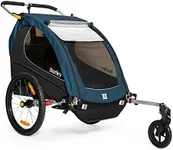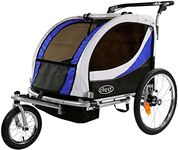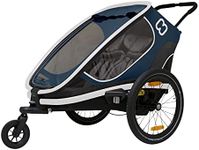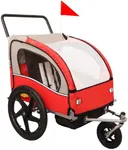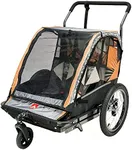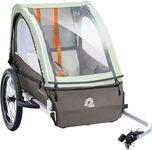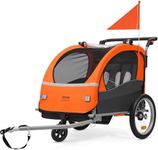Buying Guide for the Best Bike Trailer Stroller Combo
Choosing the right bike trailer stroller combo can be a game-changer for active families who want to enjoy outdoor activities with their little ones. This versatile product allows you to switch between biking, strolling, and sometimes even jogging, making it a convenient and practical choice. To ensure you pick the best fit for your needs, it's important to understand the key specifications and how they align with your lifestyle and preferences.Weight CapacityWeight capacity refers to the maximum weight the trailer stroller can safely carry, including both the child and any additional cargo. This spec is crucial because it ensures the safety and comfort of your child. Weight capacities typically range from 75 to 125 pounds. If you have one child, a lower capacity might suffice, but for two children or if you plan to carry extra gear, opt for a higher capacity. Always consider your child's growth and any additional items you might carry to ensure the trailer stroller remains functional for a longer period.
Conversion MechanismThe conversion mechanism is how easily the trailer can switch between biking, strolling, and jogging modes. This is important for convenience and usability. Some models offer quick-release systems that allow you to change modes without tools, while others might require more effort. If you plan to frequently switch between activities, look for a model with a simple and quick conversion mechanism. If you will mostly use it in one mode, this might be less critical.
Suspension SystemA suspension system helps absorb shocks from uneven terrain, providing a smoother ride for your child. This is particularly important if you plan to use the trailer stroller on rough or bumpy surfaces. Basic models might have no suspension, which is fine for smooth pavements. Mid-range models often have basic suspension suitable for light off-road use, while high-end models feature advanced suspension systems for the best comfort on all terrains. Consider where you will be using the trailer stroller most frequently to determine the level of suspension you need.
Storage SpaceStorage space refers to the compartments and pockets available for carrying additional items like diaper bags, snacks, and toys. This is important for convenience, especially on longer outings. Some models offer minimal storage, which might be sufficient for short trips. Others provide ample space, including large rear compartments and multiple pockets, ideal for longer adventures or when you need to carry more gear. Think about how much you typically carry with you and choose a model that can accommodate your needs.
Safety FeaturesSafety features include harness systems, reflectors, and braking mechanisms that ensure your child's safety during use. This is the most critical aspect to consider. Look for a five-point harness system to keep your child securely strapped in. Reflectors and bright colors enhance visibility, especially in low-light conditions. A reliable braking system is essential for controlling the stroller, particularly on slopes. Prioritize models with comprehensive safety features to ensure peace of mind during your activities.
Foldability and PortabilityFoldability and portability refer to how easily the trailer stroller can be folded and transported. This is important for storage and travel convenience. Some models feature a compact fold that fits easily into car trunks and small storage spaces, while others might be bulkier and harder to transport. If you have limited storage space or plan to take the trailer stroller on trips, look for a model that folds compactly and is lightweight. Consider how often you will need to transport it and choose accordingly.
Weather ProtectionWeather protection includes features like rain covers, sunshades, and ventilation panels that protect your child from the elements. This is important for comfort and safety in various weather conditions. Basic models might offer minimal protection, suitable for fair weather use. More advanced models provide comprehensive weather protection, including UV-resistant sunshades, rain covers, and mesh panels for ventilation. Think about the typical weather conditions in your area and choose a model that offers adequate protection for your child.

